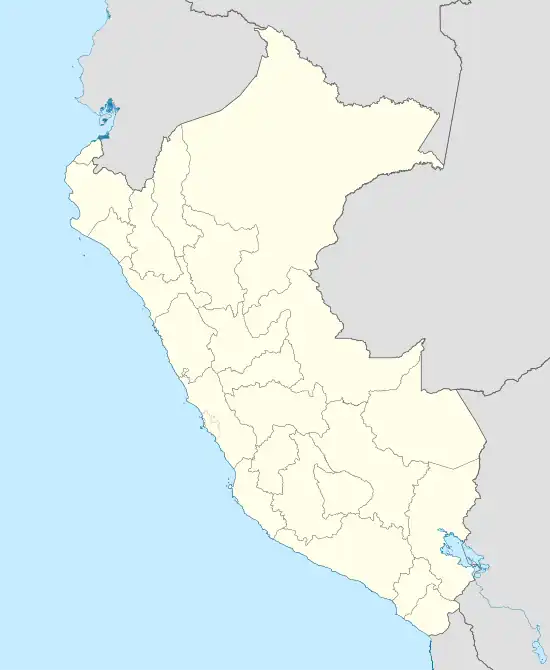Puerto Arica
Puerto Arica | |
|---|---|
Town | |
 Flag  Seal | |
| Nickname: The city of the survivors (Spanish: La ciudad de los sobrevivientes) | |
 Puerto Arica | |
| Coordinates: 2°38′10″S 73°29′56″W / 2.63611°S 73.49889°W | |
| Country | |
| Department | Loreto |
| Province | Maynas |
| District | Napo |
Puerto Arica is a Peruvian town, belonging to the province of Maynas in the Loreto region, on the banks of the Napo River, in northwestern Peru.
History
The city of Arica used to be located in southern Peru, in the province of the same name, in the Moquegua Department. During the War of the Pacific, Chilean troops invaded the town, and took it from Peruvian control, after which the Treaty of Ancón was signed, granting a large amount of Peruvian territory to Chile, with Arica becoming a commune of the Department of the same name, within the new Province of Tacna. After the Treaty of Lima, the territory was unconditionally given to Chile.[1]
The refugees who left or were expelled from the region by Chilean forces were then sent by the Peruvian government to the Loreto region in order to populate the area. Those from Tarapacá settled in what would become Nuevo Tarapacá, in Maynas Province, and those from Arica settled in what would become Puerto Arica, in northern Loreto.[2] After the Salomón–Lozano Treaty, the area was ceded to Colombia, and the original settlers moved south to Maynas Province in eastern Loreto.[3]
Symbols
The town uses the same flag and same coat of arms as the Chilean city of Arica.
Transportation
Virtually all transport takes place in the Napo river, which connects it to nearby Mazán, Indiana, and Santa Clotilde. There's also a road that connects it to nearby Flor de Agosto, located 50 minutes away from the town, in the border with Colombia.[4]
Religion
Christianity is predominant, with evangelics as the majority, followed by Catholics, and a small number of Jews, indigenous religions, as well as the Evangelical Association of the Israelite Mission of the New Universal Covenant.
See also
References
- ↑ Tamayo, José (1985). Nuevo Compendio de Historia del Perú. Editorial Lumen. pp. 288–289.
- ↑ Núñez Atencio, Lautaro y Maldonado Prieto, Carlos (2005). Reseña bibliográfica: El Dios Cautivo. Las Ligas Patrióticas en la chilenización compulsiva de Tarapacá (1910-1922), Sergio González Miranda, LOM Ediciones, Santiago, 2004. Vol. 37. Chungará (Arica), Universidad de Tarapacá. ISSN 0717-7356. .
{{cite book}}: CS1 maint: multiple names: authors list (link) - ↑ Porras Barrenechea, Raúl. Historia de los límites del Perú (PDF). Librería Francesa Científica y Casa Editorial E. Rosay. pp. 79–80. Archived from the original (PDF) on 6 November 2014.
- ↑ https://portal.mtc.gob.pe/transportes/caminos/normas_carreteras/Mapas%20RVD/Loreto/LO-102.pdf